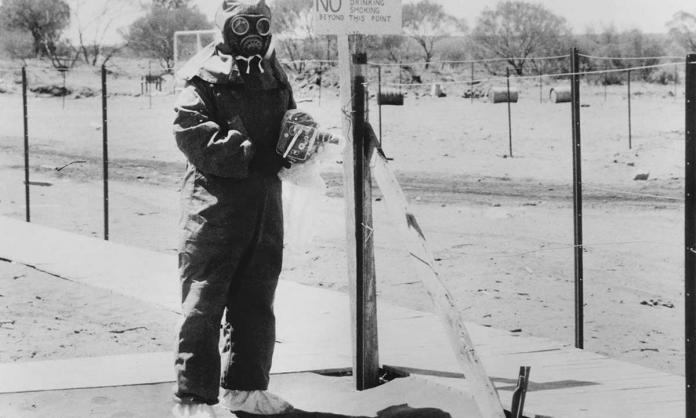“Australia has always pursued a world without nuclear weapons”, tweeted Foreign Affairs Minister Penny Wong on 5 March, the first International Day for Disarmament and Non-Proliferation Awareness. “We are redoubling our efforts towards this goal and to strengthening the non-proliferation regime.”
Wong either needs a history lesson or, more likely, is lying through her teeth. While Australia has not yet developed nuclear weapons of its own, Australian governments have long been enthusiastic supporters of nuclear proliferation.
As early as World War Two, Australia was contributing to the development of nuclear arms. In 1944, the British approached Prime Minister John Curtin to brief him on the atomic bomb effort and the pressing need for uranium for “Empire and war purposes”. The Australian government then rushed to seize control of known uranium deposits and prospected for further deposits in uranium-rich South Australia. These were exploited for the combined nuclear weapons program of the US and the UK.
This effort culminated in the murder of more than 100,000 Japanese civilians in just two bomb blasts. The longer-term result, heralded by the Soviet Union’s successful atomic tests in 1949, was to lock the planet into a seemingly endless nightmare of nuclear arms development.
As a new era of imperialist competition emerged after the war, ruling classes around the world embarked on a reckless nuclear arms race. The major powers behind the bomb, the US and UK, sought to enhance the destructive capacity of their existing technology, determined always to keep ahead of their competitors. Others, such as France, sought to develop their own nuclear program. While the Australian ruling class has often toyed with the idea of its very own nuclear arsenal, for the most part it has been content to see its allies win the arms race.
To this end, Australia supported nuclear proliferation in the Cold War, not only by supplying the world’s reactors with uranium, but by providing test sites for British nuclear weapons at Emu Field and Maralinga in South Australia’s northern deserts.
Liberal Prime Minister Robert Menzies propagated the myth that the desert was uninhabited, saying in 1953 that atomic testing would “produce no conceivable injury to life, limb or property”. Meanwhile, many Anangu Pitjantjatjara people were being removed from their traditional lands to make way for the tests. Others remained in the desert, having evaded contact with whites.
The explosions devastated and displaced Indigenous communities. Puyu (black mist) enveloped campsites, filling the air with a metallic smell and taste. Judy Mayawara, quoted in the book Maralinga: The Anangu Story, recalled “people getting sick from the smoke. Vomiting green vomit. Passing green faeces. My son Kelly went blind for a while from the smoke. Got his sight back but developed a squint. Had to wear glasses. My sister died”.
Within days, the older members of this group (at Wallatinna) died. More died throughout the region from the subsequent years of bombing, although the lack of official reports, and the long-term nature of radiation’s effects, makes it hard to put a number on casualties.
What we do know is that the nuclear testing at Maralinga exposed more than 1,000 Indigenous people to dangerous radioactive fallout. White servicemen were also used as guinea pigs to test the effects of nukes. This human toll, as well as the ongoing contamination of the environment, was the price paid for the Australia’s commitment to nuclear proliferation.
Prime Minister Bob Hawke helped to bury any Labor Party opposition to uranium with the “three mines” policy in 1984, which allowed for “only” three uranium mines (including at the world’s largest known uranium reserve at Olympic Dam). In 1996, Labor dropped even this restriction from its platform, giving bipartisan support to the uranium industry’s expansion.
Nonetheless, the repeated failure of Labor and Liberal governments to establish a nuclear waste dump in South Australia or the Northern Territory speaks to widespread public distrust of the nuclear industry. As recently as 2016, mass protests killed such a dumping proposal.
Penny Wong claims that Australia is committed to “strengthening the non-proliferation regime”. “Australia’s motivation is peace”, she claimed, justifying the AUKUS pact. In fact, the Labor government’s immense military spending represents a step towards war. AUKUS will intensify imperialist rivalry and accelerate a regional arms race as Australia asserts itself in the South Pacific. It also does more than any policy in recent history to facilitate to US nuclear threat—Wong herself has defended the right of American nuclear-armed bombers to use an air base south of Darwin.
While AUKUS is primarily driven by Australia’s overseas imperialist interests, Labor also sees it as a vehicle to introduce elements of the nuclear fuel cycle never before seen in Australia. With nuclear-powered submarines at the centre of the project, the government intends to finally establish a nuclear waste dump, which in turn creates a foot in the door for more general nuclear energy generation, a long-term aspiration of the ruling class and a necessary step if Australia were ever to produce nuclear weapons of its own.
In this context, the Albanese government’s stated support for the Treaty on the Prohibition of Nuclear Weapons is hypocritical. If it were serious about ridding the world of nuclear weapons, it would ban the export of uranium. Support for disarmament would also mean breaking the alliance with the United States, the most dangerous nuclear-armed state on the planet.








